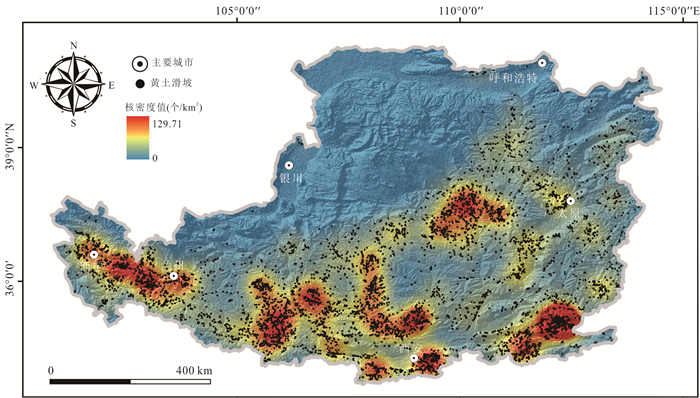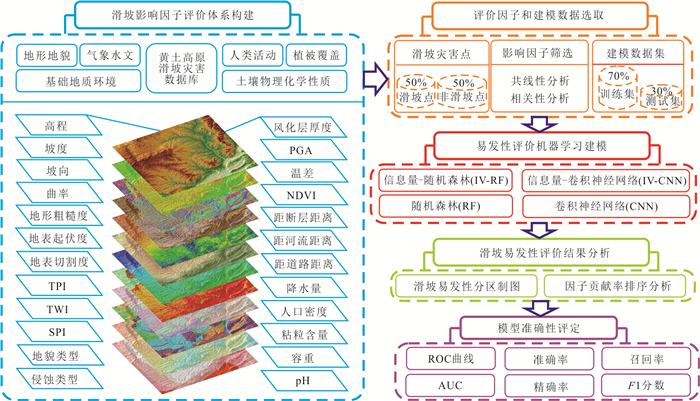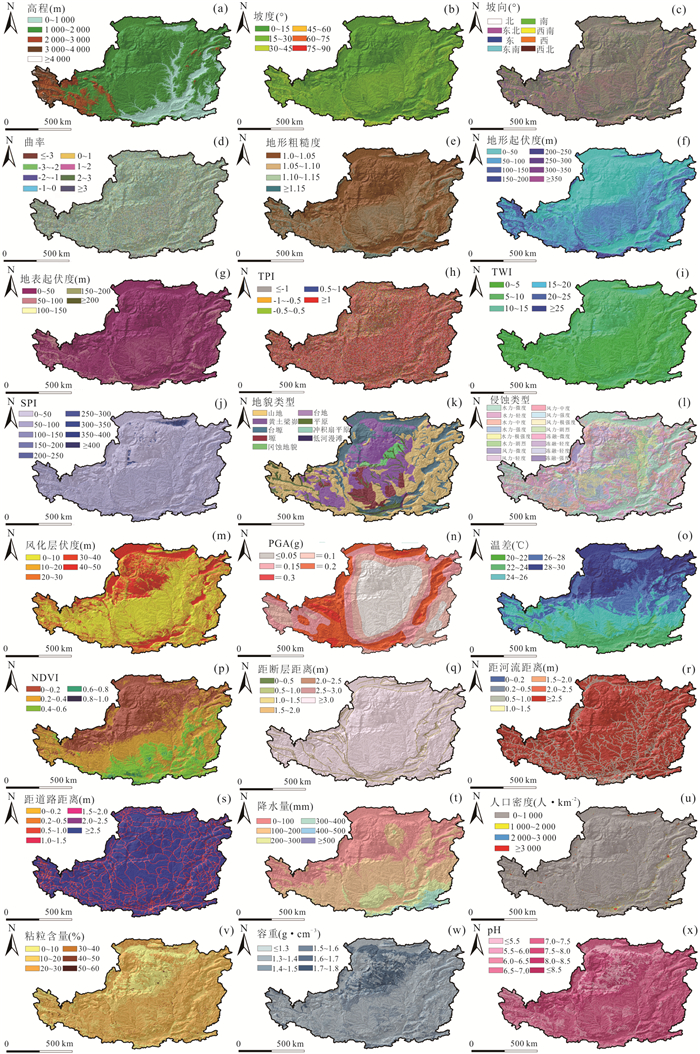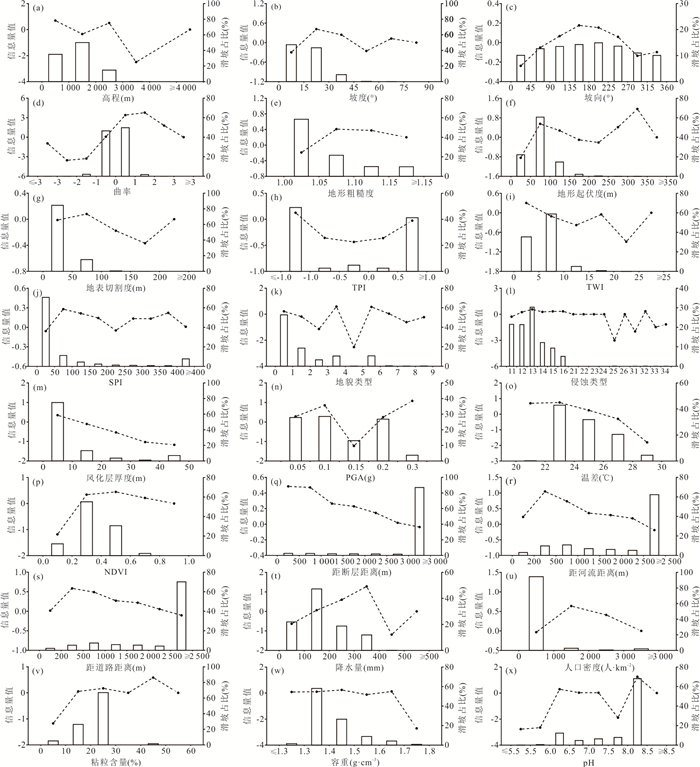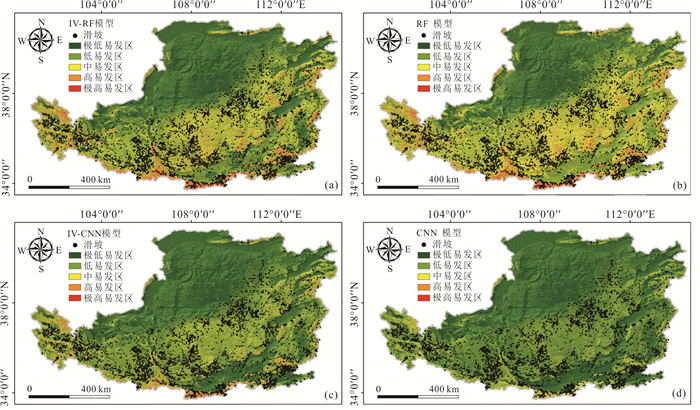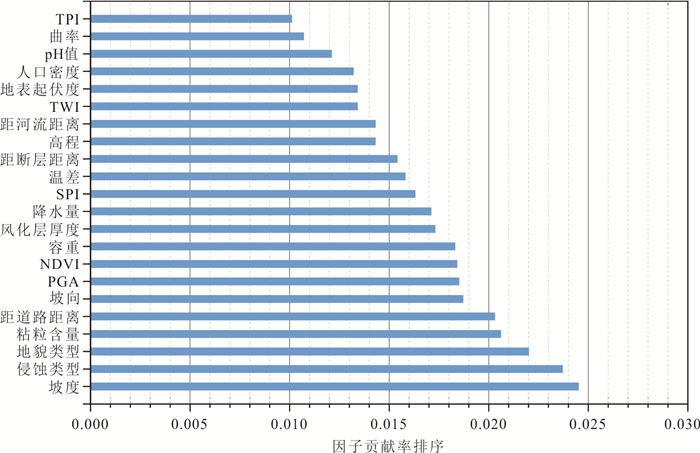Evaluation of Landslide Susceptibility in Chinese Loess Plateau Based on IV-RF and IV-CNN Coupling Models
-
摘要: 黄土高原在地质环境与人类活动的复杂互馈作用下易导致黄土崩滑灾害频发,亟需选择适用性的影响因子和训练模型开展滑坡易发性评价研究.本研究以黄土高原为研究区,基于野外滑坡调查和资料收集,构建涵盖地形地貌、基础地质环境、气象水文、人类活动、土壤物理化学性质以及植被覆盖的评价体系,采用信息量模型(IV)分别联接到随机森林模型(RF)和卷积神经网络模型(CNN)构建耦合模型IV-RF和IV-CNN,开展滑坡易发性评价研究.结果表明,耦合模型(IV-RF、IV-CNN)的精度均高于独立模型(RF、CNN),4种模型的AUC值分别为0.916、0.938、0.878、0.853,IV-CNN具有更强的预测能力和精度.IV-CNN模型的极高、高、中、低、极低易发性区域面积占比分别为8.78%、7.47%、15.34%、19.82%、47.87%,主要分布在黄土高原南部和东部地质环境复杂和人类活动强烈的山地、黄土梁峁地区.坡度、侵蚀类型、地貌类型、粘粒含量、距道路距离在贡献率分析中排在前5位,是影响滑坡发育的主控因子.本研究旨在为黄土高原滑坡灾害的预测和防治工作提供可靠的科学依据,为滑坡易发性评价研究深化建模思路,优化独立模型评价结果不确定性问题.Abstract: Due to the complex interaction between geological environment and human activities, the Chinese Loess Plateau (CLP) is prone to frequent landslides. It is urgent to carry out landslide vulnerability assessment, selecting suitable influencing factors and training models. In this study, the CLP was taken as the study area. Based on field landslide survey and data collection, an evaluation system including topography, basic geological environment, meteorology and hydrology, human activities, soil physical and chemical properties, and vegetation coverage was built. The information model (IV) was used to connect the random forest model (RF) and convolutional neural network model (CNN) to build coupling models IV-RF and IV-CNN, and landslide susceptibility evaluation research was carried out. The results show that the accuracy of the coupling model (IV-RF, IV-CNN) is higher than that of the independent model (RF, CNN), and the AUC values of the four models are 0.916, 0.938, 0.878, and 0.853, respectively. The IV-CNN has stronger prediction ability and accuracy. The areas of extremely high, high, medium, low, and extremely low vulnerability areas in the IV-CNN model account for 8.78%, 7.47%, 15.34%, 19.82%, and 47.87% respectively, which are mainly distributed in the mountainous and loess hilly areas with complex geological environment and strong human activities in the south and east of the loess plateau. Slope, erosion type, landform type, clay content and distance from the road rank in the top five in the contribution rate analysis, and are the main control factors affecting the landslide development. The purpose of this study is to provide reliable scientific basis for the prediction and prevention of landslide disasters in the CLP, deepen the modeling idea for landslide vulnerability evaluation research, and optimize the uncertainty of independent model evaluation results.
-
图 5 评价因子分级信息量值与滑坡分布百分比
图 5h:TPI值表示滑坡位置的含义,处于≤-1区间为山谷;处于-1~-0.5区间为高坡;处于-0.5~0.5区间为平地;处于0.5~1区间为低坡;处于≥1区间为山脊;图 5k:1.山地;2.黄土梁峁;3.台塬;4.塬;5.冈蚀地貌;6.台地;7.平原;8.冲积扇平原;9.低河漫滩;图 5l:11.水力侵蚀微度;12.水力侵蚀轻度;13.水力侵蚀中度;14.水力侵蚀强度;15.水力侵蚀极强度;16.水力侵蚀剧烈;21.风力侵蚀微度;22.风力侵蚀轻度;23.风力侵蚀中度;24.风力侵蚀强度;25.风力侵蚀极强度;26.风力侵蚀剧烈;31.冻融侵蚀微度;32.冻融侵蚀轻度;33.冻融侵蚀中度;34.冻融侵蚀强度
Fig. 5. Grading information value of evaluation factors and percentage of landslide distribution
表 1 黄土高原滑坡灾害调查基础信息
Table 1. Results of precision evaluation indexes of different models
甘肃 河南 内蒙古 宁夏 青海 山西 陕西 滑坡数量(个) 1 643 773 41 328 511 1 255 1 996 威胁人口(人) 201 189 8 417 9 366 14 321 49 809 43 726 113 299 威胁财产(万元) 216 802.9 37 430.16 19 781.8 25 335.5 38 289.9 67 611.1 141 526.9 表 2 研究区所有数据来源与因子评价体系
Table 2. All data sources and factor evaluation system in the study area
一级因子 二级因子 数据来源 数据类型 精度 地形地貌 高程 ASTER卫星 连续型 30 m 坡度 基于SAGA 7.0软件地形分析模块和ASTER 30 m-DEM计算和提取 连续型 30 m 坡向 连续型 30 m 曲率 连续型 30 m 地形粗糙度 连续型 30 m 地形起伏度 连续型 30 m 地表切割度 连续型 30 m 地形位置指数(TPI) 连续型 30 m 地貌类型 中华人民共和国地貌图集 离散型 30 m 基础地质 距断层距离 中国国家地质资料数据中心 连续型 500 m 风化层厚度 美国NASA(DACC)部门 连续型 1 km 侵蚀类型 中华人民共和国行业标准SL190-96《土壤侵蚀分类分级标准》 离散型 1 km PGA 中国地震动峰值加速度区划图GB18306-2015 离散型 500 m 气象水文 距河流距离 中国1:400万主要基础数据集 连续型 500 m 地形湿度指数(TWI) 基于SAGA 7.0软件地形分析模块和ASTER 30 m-DEM计算和提取 连续型 30 m 径流强度指数(SPI) 连续型 30 m 温差 中国气象数据网 连续型 1 km 降水量 中国气象数据网 连续型 1 km 土壤物理化学性质 粘粒含量 《Predictive Soil Mapping with R》 连续型 1 km 土壤容重 《Predictive Soil Mapping with R》 连续型 1 km pH值 《Predictive Soil Mapping with R》 连续型 1 km 人类活动 距道路距离 中国1:400万主要基础数据集 连续型 500 m 人口密度 美国NASA(SEDAC)部门 连续型 1 km 植被覆盖 NDVI 地理空间数据云Landsat-8遥感影像 连续型 1 km 表 3 研究区影响因子的方差膨胀系数和容忍度
Table 3. Variance expansion coefficient and tolerance of influencing factors in the study area
影响因子 TOL VIF 影响因子 TOL VIF 高程 0.383 2.614 风化层厚度 0.942 1.061 坡度 0.156 6.430 PGA 0.598 1.671 坡向 0.983 1.017. 温差 0.332 3.014 曲率 0.437 2.286 NDVI 0.347 2.881 地表粗糙度 0.137 7.471 距断层距离 0.518 1.932 地表起伏度 0.142 7.045 距河流距离 0.841 1.190 地形切割度 0.133 7.541 距道路距离 0.908 1.101 TPI 0.330 3.030 降水量 0.209 4.776 TWI 0.644 1.552 人口密度 0.858 1.166 SPI 0.973 1.028 黏粒含量 0.614 1.628 地貌类型 0.777 1.287 容重 0.567 1.765 侵蚀类型 0.690 1.449 pH值 0.788 1.269 表 4 不同模型滑坡易发性分区结果
Table 4. Landslide susceptibility zoning results of different models
模型 易发性
分区分区面积(km2) 分区面积占比(%) 滑坡数量
(个)滑坡数量占比(%) 滑坡密度
(个/km2)极低易发区 276 947.05 37.83 419 6.43 0.001 5 低易发区 158 161.20 21.60 913 14.01 0.005 8 IV-RF 中易发区 152 122.02 20.78 1 332 20.44 0.008 8 高易发区 53 706.53 7.34 1 244 19.09 0.023 2 极高易发区 91 126.22 12.45 2 609 40.03 0.028 6 极低易发区 246 144.33 33.62 368 5.65 0.001 5 低易发区 172 161.04 23.52 928 14.24 0.005 4 RF 中易发区 165 922.21 22.67 1 401 21.50 0.008 4 高易发区 55 709.23 7.61 1 111 17.05 0.019 9 极高易发区 92 126.22 12.58 2 709 41.57 0.029 4 极低易发区 352 947.06 47.87 485 4.37 0.001 4 低易发区 146 161.28 19.82 902 13.84 0.006 7 IV-CNN 中易发区 113 121.52 15.34 1 053 16.16 0.012 5 高易发区 55 106.94 7.47 1 654 25.38 0.024 6 极高易发区 64 726.22 8.78 2 423 40.25 0.023 8 极低易发区 383 846.51 52.43 321 4.93 0.000 8 低易发区 157 377.92 21.50 974 14.95 0.006 2 CNN 中易发区 102 388.24 13.99 1 348 20.68 0.013 2 高易发区 46 492.08 6.35 1 886 28.94 0.040 6 极高易发区 41 958.27 5.73 1 988 30.50 0.047 4 表 5 不同模型精度评价指标结果
Table 5. Results of precision evaluation indexes of different models
模型 模型精度评价指标 AUC 准确率 精确率 召回率 F1分数 IV-RF 0.916 0.823 0.901 0.904 0.882 RF 0.878 0.812 0.821 0.812 0.819 IV-CNN 0.938 0.842 0.926 0.934 0.912 CNN 0.853 0.816 0.857 0.843 0.841 -
Dou, J., Xiang, Z. L., Xu, Q., et al., 2023. Application and Development Trend of Machine Learning in Landslide Intelligent Disaster Prevention and Mitigation. Earth Science, 48(5): 1657-1674 (in Chinese with English abstract). Du, B., Zhao, Z. R., Hu, X., et al., 2021. Landslide Susceptibility Prediction Based on Image Semantic Segmentation. Computers & Geosciences, 155: 104860. https://doi.org/10.1016/j.cageo.2021.104860 Fan, X. M., Fang, C. Y., Dai, L. X., et al., 2022. Near Real Time Prediction of Spatial Distribution Probability of Earthquake-Induced Landslides: Take the Lushan Earthquake on June 1, 2022 as an Example. Journal of Engineering Geology, 30(3): 729-739 (in Chinese with English abstract). Feng, L., Lin, H. S., Zhang, M. S., et al., 2019. Development and Evolution of Loess Vertical Joints on the Chinese Loess Plateau at Different Spatiotemporal Scales. Engineering Geology, 265: 105372. https://doi.org/10.1016/j.enggeo.2019.105372 Gao, D. H., Chen, Z. H., Guo, N., et al., 2017. The Influence of Dry Density and Matric Suction on the Deformation and the Strength Characteristics of the Remolded Unsaturated Loess Soils. Chinese Journal of Rock Mechanics and Engineering, 36(3): 736-744 (in Chinese with English abstract). http://d.wanfangdata.com.cn/periodical/yslxygcxb201703022 González-Díez, A., Fernández-Maroto, G., Doughty, M. W., et al., 2014. Development of a Methodological Approach for the Accurate Measurement of Slope Changes Due to Landslides, Using Digital Photogrammetry. Landslides, 11: 615-628. https://doi.org/10.1007/s10346-013-0413-5 Guo, F. Y., Meng, X. M., Li, Z. H., et al., 2015. Characteristics and Causes of Assembled Geo-Hazards Induced by the Rainstorm on 25th July 2013 in Tianshui City, Gansu, China. Mountain Research, 33(1): 100-107 (in Chinese with English abstract). http://en.cnki.com.cn/Article_en/CJFDTOTAL-SDYA201501014.htm Guo, Z. Z., Yin, K. L., Fu, S., et al., 2019. Evaluation of Landslide Susceptibility Based on GIS and WOE-BP Model. Earth Science, 44(12): 4299-4312 (in Chinese with English abstract). http://www.researchgate.net/publication/324390254_Evaluation_of_Landslide_Susceptibility_Based_on_GIS_and_WOE-BP_Model Guzzetti, F., Ardizzone, F., Cardinali, M., et al., 2008. Distribution of Landslides in the Upper Tiber River Basin, Central Italy. Geomorphology, 96(1-2): 105-122. https://doi.org/10.1016/j.geomorph.2007.07.015 Guzzetti, F., Mondini, A. C., Cardinali, M., et al., 2012: Landslide Inventory Maps: New Tools for an Old Problem. Earth-Science Reviews, 112(1-2): 42-66. https://doi.org/10.1016/j.earscirev.2012.02.001 Hengl, T., MacMillan, R. A., 2019. Predictive Soil Mapping with R. Open GeoHub Foundation, Wageningen, 1-370. Hou, R. N., Li, Z., Chen, N. S., et al., 2023. Modeling of Debris Flow Susceptibility Assessment in Tianshan Based on Watershed Unit and Stacking Ensemble Algorithm. Earth Science, 48(5): 1892-1907 (in Chinese with English abstract). Hu, W. L., Cheng, W. C., Wen, S. J., et al., 2021. Effects of Chemical Contamination on Microscale Structural Characteristics of Intact Loess and Resultant Macroscale Mechanical Properties. CATENA, 203: 105361. https://doi.org/10.1016/j.catena.2021.105361 Huang, F. M., Chen, B., Mao, D. X., et al., 2023. Landslide Susceptibility Prediction Modeling and Interpretability Based on Self-Screening Deep Learning Model. Earth Science, 48(5): 1696-1710 (in Chinese with English abstract). Huang, F. M., Li, J. F., Wang, J. Y., et al., 2022a. Modelling Rules of Landslide Susceptibility Prediction Considering the Suitability of Linear Environmental Factors and Different Machine Learning Models. Bulletin of Geological Science and Technology, 41(2): 44-59 (in Chinese with English abstract). Huang, F. M., Shi, Y., Ouyang, W. P., et al., 2022b. Landslide Susceptibility Prediction Modeling Based on Weight of Evidence and Chi-Square Automatic Interactive Detection. Journal of Civil and Environmental Engineering, 44(5): 16-28 (in Chinese with English abstract). Huang, F. M., Yin, K. L., Jiang, S. H., et al., 2018. Landslide Susceptibility Assessment Based on Clustering Analysis and Support Vector Machine. Chinese Journal of Rock Mechanics and Engineering, 37(1): 156-167 (in Chinese with English abstract). http://search.cnki.net/down/default.aspx?filename=YSLX201801016&dbcode=CJFD&year=2018&dflag=pdfdown Huang, F. M., Zhang, J., Zhou, C. B., et al., 2020. A Deep Learning Algorithm Using a Fully Connected Sparse Autoencoder Neural Network for Landslide Susceptibility Prediction. Landslides, 17(1): 217-229. https://doi.org/10.1007/s10346-019-01274-9 Huang, R. Q., 2007. Large-Scale Landslides and Their Sliding Mechanisms in China since the 20th Century. Chinese Journal of Rock Mechanics and Engineering, 26(3): 433-454 (in Chinese with English abstract). http://en.cnki.com.cn/Article_en/CJFDTOTAL-YSLX200703000.htm Huang, X. W., 2019. Hazard and Risk Evaluation of Fatal Landslides in China and the Landslides on the Loess Plateau (Dissertation). Lanzhou University, Lanzhou, 8-9 (in Chinese with English abstract). Kong, J. X., Zhuang, J. Q., Peng, J. B., et al., 2021. Spatial and Temporal Distribution Characteristics and Risk Simulation of Loess Micro Geomorphic Disaster Chain in Laolang Gully, Lanzhou. Journal of Engineering Geology, 29(5): 1401-1415 (in Chinese with English abstract). Kong, J. X., Zhuang, J. Q., Zhan, J. W., et al., 2021. A Landslide in Heifangtai, Northwest of the Chinese Loess Plateau: Triggered Factors, Movement Characteristics, and Failure Mechanism. Landslides, 18: 3407-3419. https://doi.org/10.1007/s10346-021-01752-z Leng, Y. Q., Peng, J. B., Wang, S., et al., 2020. Development of Water Sensitivity Index of Loess from Its Mechanical Properties. Engineering Geology, 280: 105918. https://doi.org/10.1016/j.enggeo.2020.105918 Li, W. B., Fan, X. M., Huang, F. M., et al., 2021. Uncertainties of Landslide Susceptibility Modeling under Different Environmental Factor Connections and Prediction Models. Earth Science, 46(10): 3777-3795 (in Chinese with English abstract). http://www.sciencedirect.com/science/article/pii/S0341816221001090 Li, Y. R., Shi, W. H., Aydin, A., et al., 2019. Loess Genesis and Worldwide Distribution. Earth-Science Reviews, 201: 102947. https://doi.org/10.1016/j.earscirev.2019.102947 Liu, K., Ye, W. J., Jing, H. J., et al., 2021. Microscopic Damage Identification and Macroscopic Mechanical Response of Loess in Seasonal Frozen Areas. Chinese Journal of Geotechnical Engineering, 43(S1): 192-197 (in Chinese with English abstract). Ma, P. H., Peng, J. B., Zhuang, J. Q., et al., 2022. Initiation Mechanism of Loess Mudflows by Flume Experiments. Journal of Earth Science, 33(5): 1166-1178. https://doi.org/10.1007/s12583-022-1660-y Malamud, B. D., Turcotte, D. L., Guzzetti, F., et al., 2004. Landslide Inventories and Their Statistical Properties. Earth Surface Processes and Landforms, 29: 687-711. https://doi.org/10.1002/esp.1064 Merghadi, A., Yunus, A. P., Dou, J., et al., 2020. Machine Learning Methods for Landslide Susceptibility Studies: A Comparative Overview of Algorithm Performance. Earth-Science Reviews, 207: 103255. https://doi.org/10.1016/j.earscirev.2020.103225 Peng, J. B., Wang, S. K., Wang, Q. Y., et al., 2019. Distribution and Genetic Types of Loess Landslides in China. Journal of Asian Earth Sciences, 170: 329-350. https://doi.org/10.1016/j.jseaes.2018.11.015 Peng, J. B., Wu, D., Duan, Z., et al., 2016. Disaster Characteristics and Destructive Mechanism of Typical Loess Landslide Cases Triggered by Human Engineering Activities. Journal of Southwest Jiaotong University, 51(5): 971-980 (in Chinese with English abstract). http://www.cqvip.com/QK/92056X/20165/670271568.html Qiu, H. J., Regmi, A. D., Cui, P., et al., 2016. Size Distribution of Loess Slides in Relation to Local Slope Height within Different Slope Morphologies. CATENA, 145: 155-163. https://doi.org/10.1016/j.catena.2016.06.005 Reichenbach, P., Rossi, M., Malamud, B. D., et al., 2018. A Review of Statistically-Based Landslide Susceptibility Models. Earth-Science Reviews, 180: 60-91. https://doi.org/10.1016/j.earscirev.2018.03.001 Samia, J., Arnaud, T., Bregt, A., et al., 2017. Do Landslides Follow Landslides? Insights in Path Dependency from a Multi-Temporal Landslide Inventory. Landslides, 4: 547-558. https://doi.org/10.1007/s10346-016-0739-x Segoni, S., Pappafico, G., Luti, T., et al., 2020. Landslide Susceptibility Assessment in Complex Geological Settings: Sensitivity to Geological Information and Insights on Its Parameterization. Landslides, 17(10): 2443-2453. doi: 10.1007/s10346-019-01340-2 Tian, S. J., Zhang, S. S., Tang, Q. S., et al., 2019. Comparative Study of Landslide Susceptibility Assessment Based on Different Evaluation Units. Journal of Natural Disasters, 28(6): 137-145 (in Chinese with English abstract). Tu, X. B., Kwong, A. K. L., Dai, F. C., et al., 2009. Field Monitoring of Rainfall Infiltration in a Loess Slope and Analysis of Failure Mechanism of Rainfall-Induced Landslides. Engineering Geology, 105(1-2): 134-150. https://doi.org/10.1016/j.enggeo.2008.11.011 Wang, J. D., Gu, T. F., Zhang, M. S., et al., 2019a. Experimental Study of Loess Disintegration Characteristics. Earth Surface Processes and Landforms, 44(6): 1317-1329. https://doi.org/10.1002/esp.4575 Wang, Y., Fang, Z. C., Hong, H. Y., 2019b. Comparison of Convolutional Neural Networks for Landslide Susceptibility Mapping in Yanshan County, China. The Science of the Total Environment, 666: 975-993. https://doi.org/10.1016/j.scitotenv.2019.02.263 Wang, S. B., Zhuang, J. Q., Zheng, J., et al., 2021. Landslide Susceptibility Evaluation Based on Deep Learning along Kangding-Litang Section of Sichuan-Tibet Railway. Journal of Engineering Geology, 30(8): 909-918 (in Chinese with English abstract). Wang, Y., Fang, Z. C., Niu, R. Q., et al., 2021. Landslide Susceptibility Analysis Based on Deep Learning. Journal of Geo-Information Science, 23(12): 2244-2260 (in Chinese with English abstract). Wu, R. Z., Hu, X. D., Mei, H. B., et al., 2021. Spatial Susceptibility Assessment of Landslides Based on Random Forest: A Case Study from Hubei Section in the Three Gorges Reservoir Area. Earth Science, 46(1): 321-330(in Chinese with English abstract). Wu, X. L., Yang, J. Y., Niu, R. Q., 2020. A Landslide Susceptibility Assessment Method Using SMOTE and Convolutional Neural Network. Geomatics and Information Science of Wuhan University, 45(8): 1223-1232 (in Chinese with English abstract). Xu, C., Dai, F. C., Yao, X., et al., 2010. GIS Platform and Certainty Factor Analysis Method Based Wenchuan Earthquake-Induced Landslide Susceptibility Evaluation. Journal of Engineering Geology, 18(1): 15-26 (in Chinese with English abstract). http://www.wanfangdata.com.cn/details/detail.do?_type=perio&id=gcdzxb201001003 Xu, S. H., Liu, J. P., Wang, X. H., et al., 2020. Landslide Susceptibility Assessment Method Incorporating Index of Entropy Based on Support Vector Machine: A Case Study of Shaanxi Province. Geomatics and Information Science of Wuhan University, 45(8): 1214-1222 (in Chinese with English abstract). Xu, Y. R., Allen, M. B., Zhang, W. H., et al., 2020. Landslide Characteristics in the Loess Plateau, Northern China. Geomorphology, 359: 107150. https://doi.org/10.1016/j.geomorph.2020.107150 Yang, Q., Wang, G. F., Ding, W. C., et al., 2021. Susceptibility and Accuracy Evaluation of Regional Landsldie Based on Multiple Hybrid Models. Journal of Natural Disasters, 30(2): 36-51 (in Chinese with English abstract). Zhang, H. J., Song, Y. X., Xu, S. L., et al., 2021. Combining a Class-Weighted Algorithm and Machine Learning Models in Landslide Susceptibility Mapping: A Case Study of Wanzhou Section of the Three Gorges Reservoir, China. Computers & Geosciences, 158: 104966. https://doi.org/10.1016/j.cageo.2021.104966 Zhang, M. S., Li, T. L., 2011. Triggering Factors and Forming Mechanism of Loess Landslides. Journal of Engineering Geology, 19(4): 530-540 (in Chinese with English abstract). http://www.researchgate.net/publication/285444566_Triggering_factors_and_forming_mechanism_of_loess_landslides Zhang, W. G., He, Y. W., Wang, L. Q., et al., 2023. Machine Learning Solution for Landslide Susceptibility Based on Hydrographic Division: A Case Study of Fengjie County in Chongqing. Earth Science, 48(5): 2024-2038 (in Chinese with English abstract). Zhang, X. C., Pei, X. J., Zhang, M. S., et al., 2018. Experimental Study on Mechanism of Flow Slide of Loess Landslides Triggered by Strong Earthquake: A Case Study in Dangjiacha, Ningxia Province. Journal of Engineering Geology, 26(5): 1219-1226 (in Chinese with English abstract). http://en.cnki.com.cn/Article_en/CJFDTotal-GCDZ201805013.htm Zhang, Z. H., 1981. Regional Geological and Morphological Characteristics and Development of Soil Erosion in the Loess Plateau, China. Acta Geologica Sinica, (4): 308-320, 326 (in Chinese with English abstract). http://en.cnki.com.cn/Article_en/CJFDTOTAL-DZXE198104007.htm Zhou, C., Yin, K. L., Cao, Y., et al., 2020. Landslide Susceptibility Assessment by Applying the Coupling Method of Radial Basis Neural Network and Adaboost: A Case Study from the Three Gorges Reservoir Area. Earth Science, 45(6): 1865-1876 (in Chinese with English abstract). Zhou, P., Deng, H., Zhang, W. J., et al., 2022. Landslide Susceptibility Evaluation Based on Information Value Model and Machine Learning Method: A Case Study of Lixian County, Sichuan Province. Scientia Geographica Sinica, 42(9): 1665-1675 (in Chinese with English abstract). Zhuang, J. Q., Cui, P., Ge, Y. G., et al., 2010. Risk Assessment of Collapses and Landslides Caused by 5.12 Wenchuan Earthquake—A Case Study of Dujiangyan-Wenchuan Highway. Chinese Journal of Rock Mechanics and Engineering, 29(S2): 3735-3742 (in Chinese with English abstract). http://www.cqvip.com/QK/71135X/201107/35616544.html Zhuang, J. Q., Peng, J. B., Wang, G. H., et al., 2018. Distribution and Characteristics of Landslide in Loess Plateau: A Case Study in Shaanxi Province. Engineering Geology, 236: 89-96. https://doi.org/10.1016/j.enggeo.2017.03.001 Zhuang, J. Q., Peng, J. B., Zhu, Y., 2020. Study of the Effects of Clay Content on Loess Slope Failure Mode and Loess Strength. Bulletin of Engineering Geology and the Environment, 80: 1999-2009. https://doi.org/10.1007/s10064-020-02055-8 Zou, Q., Jiang, H., Cui, P., et al., 2021. A New Approach to Assess Landslide Susceptibility Based on Slope Failure Mechanisms. CATENA, 204: 105388. https://doi.org/10.1016/j.catena.2021.105388 窦杰, 向子林, 许强, 等, 2023. 机器学习在滑坡智能防灾减灾中的应用与发展趋势. 地球科学, 48(5): 1657-1674. https://www.cnki.com.cn/Article/CJFDTOTAL-DQKX202305001.htm 范宣梅, 方成勇, 戴岚欣, 等, 2022. 地震诱发滑坡空间分布概率近实时预测研究: 以2022年6月1日四川芦山地震为例. 工程地质学报, 30(3): 729-739. https://www.cnki.com.cn/Article/CJFDTOTAL-GCDZ202203012.htm 高登辉, 陈正汉, 郭楠, 等, 2017. 干密度和基质吸力对重塑非饱和黄土变形与强度特性的影响. 岩石力学与工程学报, 36(3): 736-744. https://www.cnki.com.cn/Article/CJFDTOTAL-YSLX201703023.htm 郭富赟, 孟兴民, 黎志恒, 等, 2015. 天水市"7·25"群发性地质灾害特征及成因. 山地学报, 33(1): 100-107. https://www.cnki.com.cn/Article/CJFDTOTAL-SDYA201501014.htm 郭子正, 殷坤龙, 付圣, 等, 2019. 基于GIS与WOE-BP模型的滑坡易发性评价. 地球科学, 44(12): 4299-4312. doi: 10.3799/dqkx.2018.555 侯儒宁, 李志, 陈宁生, 等, 2023. 基于流域单元和堆叠集成模型的天山地区泥石流易发性评估建模. 地球科学, 48(5): 1892-1907. https://www.cnki.com.cn/Article/CJFDTOTAL-DQKX202305027.htm 黄发明, 陈彬, 毛达雄, 等, 2023. 基于自筛选深度学习的滑坡易发性预测建模及其可解释性. 地球科学, 48(5): 1696-1710. https://www.cnki.com.cn/Article/CJFDTOTAL-DQKX202305003.htm 黄发明, 李金凤, 王俊宇, 等, 2022a. 考虑线状环境因子适宜性和不同机器学习模型的滑坡易发性预测建模规律. 地质科技通报, 41(2): 44-59. https://www.cnki.com.cn/Article/CJFDTOTAL-DZKQ202202005.htm 黄发明, 石雨, 欧阳慰平, 等, 2022b. 基于证据权和卡方自动交互检测决策树的滑坡易发性预测. 土木与环境工程学报(中英文), 44(5): 16-28. https://www.cnki.com.cn/Article/CJFDTOTAL-JIAN202205003.htm 黄发明, 殷坤龙, 蒋水华, 等, 2018. 基于聚类分析和支持向量机的滑坡易发性评价. 岩石力学与工程学报, 37(1): 156-167. https://www.cnki.com.cn/Article/CJFDTOTAL-YSLX201801016.htm 黄润秋, 2007.20世纪以来中国的大型滑坡及其发生机制. 岩石力学与工程学报, 26(3): 433-454. https://www.cnki.com.cn/Article/CJFDTOTAL-YSLX200703000.htm 黄晓维, 2019. 中国致命性滑坡和黄土高原滑坡的灾害与风险评价(硕士学位论文). 兰州: 兰州大学, 8-9. 孔嘉旭, 庄建琦, 彭建兵, 等, 2021. 兰州老狼沟黄土微地貌灾害链时空分布特征与危险性模拟研究. 工程地质学报, 29(5): 1401-1415. https://www.cnki.com.cn/Article/CJFDTOTAL-GCDZ202105016.htm 李文彬, 范宣梅, 黄发明, 等, 2021. 不同环境因子联接和预测模型的滑坡易发性建模不确定性. 地球科学, 46(10): 3777-3795. doi: 10.3799/dqkx.2021.042 刘宽, 叶万军, 景宏君, 等, 2021. 季冻区黄土微观损伤识别与宏观力学响应研究. 岩土工程学报, 43(S1): 192-197. https://www.cnki.com.cn/Article/CJFDTOTAL-YTGC2021S1037.htm 彭建兵, 吴迪, 段钊, 等, 2016. 典型人类工程活动诱发黄土滑坡灾害特征与致灾机理. 西南交通大学学报, 51(5): 971-980. https://www.cnki.com.cn/Article/CJFDTOTAL-XNJT201605021.htm 田述军, 张珊珊, 唐青松, 等, 2019. 基于不同评价单元的滑坡易发性评价对比研究. 自然灾害学报, 28(6): 137-145. https://www.cnki.com.cn/Article/CJFDTOTAL-ZRZH201906015.htm 王世宝, 庄建琦, 郑佳, 等, 2021. 基于深度学习的川藏铁路康定——理塘段滑坡易发性评价. 工程地质学报, 30(8): 909-918. https://www.cnki.com.cn/Article/CJFDTOTAL-GCDZ202203028.htm 王毅, 方志策, 牛瑞卿, 等, 2021. 基于深度学习的滑坡灾害易发性分析. 地球信息科学学报, 23(12): 2244-2260. https://www.cnki.com.cn/Article/CJFDTOTAL-DQXX202112012.htm 吴润泽, 胡旭东, 梅红波, 等, 2021. 基于随机森林的滑坡空间易发性评价: 以三峡库区湖北段为例. 地球科学, 46(1): 321-330. doi: 10.3799/dqkx.2020.032 武雪玲, 杨经宇, 牛瑞卿, 2020. 一种结合SMOTE和卷积神经网络的滑坡易发性评价方法. 武汉大学学报(信息科学版), 45(8): 1223-1232. https://www.cnki.com.cn/Article/CJFDTOTAL-WHCH202008013.htm 许冲, 戴福初, 姚鑫, 等, 2010. 基于GIS与确定性系数分析方法的汶川地震滑坡易发性评价. 工程地质学报, 18(1): 15-26. https://www.cnki.com.cn/Article/CJFDTOTAL-GCDZ201001003.htm 徐胜华, 刘纪平, 王想红, 等, 2020. 熵指数融入支持向量机的滑坡灾害易发性评价方法——以陕西省为例. 武汉大学学报(信息科学版), 45(8): 1214-1222. https://www.cnki.com.cn/Article/CJFDTOTAL-WHCH202008012.htm 杨强, 王高峰, 丁伟翠, 等, 2021. 多种组合模型的区域滑坡易发性及精度评价. 自然灾害学报, 30(2): 36-51. https://www.cnki.com.cn/Article/CJFDTOTAL-ZRZH202102004.htm 张茂省, 李同录, 2011. 黄土滑坡诱发因素及其形成机理研究. 工程地质学报, 19(4): 530-540. https://www.cnki.com.cn/Article/CJFDTOTAL-GCDZ201104015.htm 仉文岗, 何昱苇, 王鲁琦, 等, 2023. 基于水系分区的滑坡易发性机器学习分析方法——以重庆市奉节县为例. 地球科学, 48(5): 2024-2038. https://www.cnki.com.cn/Article/CJFDTOTAL-DQKX202305028.htm 张晓超, 裴向军, 张茂省, 等, 2018. 强震触发黄土滑坡流滑机理的试验研究——以宁夏党家岔滑坡为例. 工程地质学报, 26(5): 1219-1226. https://www.cnki.com.cn/Article/CJFDTOTAL-GCDZ201805013.htm 张宗祜, 1981. 我国黄土高原区域地质地貌特征及现代侵蚀作用. 地质学报, (4): 308-320, 326. https://www.cnki.com.cn/Article/CJFDTOTAL-DZXE198104007.htm 周超, 殷坤龙, 曹颖, 等, 2020. 基于集成学习与径向基神经网络耦合模型的三峡库区滑坡易发性评价. 地球科学, 45(6): 1865-1876. doi: 10.3799/dqkx.2020.071 周萍, 邓辉, 张文江, 等, 2022. 基于信息量模型和机器学习方法的滑坡易发性评价研究——以四川理县为例. 地理科学, 42(9): 1665-1675. https://www.cnki.com.cn/Article/CJFDTOTAL-DLKX202209016.htm 庄建琦, 崔鹏, 葛永刚, 等, 2010. "5·12"汶川地震崩塌滑坡危险性评价——以都汶公路沿线为例. 岩石力学与工程学报, 29(S2): 3735-3742. https://www.cnki.com.cn/Article/CJFDTOTAL-YSLX2010S2043.htm -










 下载:
下载:
